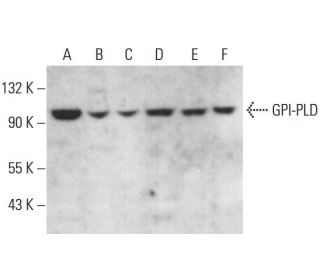



GPI-PLD Antibody (D-10): sc-365096
- GPI-PLD Antibody (D-10) is a mouse monoclonal IgG2a κ GPI-PLD antibody provided at 200 µg/ml
- raised against amino acids 1-300 of GPI-PLD of human origin
- GPI-PLD Antibody (D-10) is recommended for detection of GPI-PLD of mouse, rat and human origin by WB, IP, IF and ELISA
- Anti-GPI-PLD Antibody (D-10) is available conjugated to agarose for IP; HRP for WB, IHC(P) and ELISA; and to either phycoerythrin or FITC for IF, IHC(P) and FCM
- also available conjugated to Alexa Fluor® 488, Alexa Fluor® 546, Alexa Fluor® 594 or Alexa Fluor® 647 for WB (RGB), IF, IHC(P) and FCM, and for use with RGB fluorescent imaging systems, such as iBright™ FL1000, FluorChem™, Typhoon, Azure and other comparable systems
- also available conjugated to Alexa Fluor® 680 or Alexa Fluor® 790 for WB (NIR), IF and FCM; for use with Near-Infrared (NIR) detection systems, such as LI-COR®Odyssey®, iBright™ FL1000, FluorChem™, Typhoon, Azure and other comparable systems
- Contact our Technical Service Department (or your local Distributor) for more information on how to receive a FREE 10 µg sample of GPI-PLD (D-10): sc-365096.
- m-IgG Fc BP-HRP and m-IgG2a BP-HRP are the preferred secondary detection reagents for GPI-PLD Antibody (D-10) for WB applications. These reagents are now offered in bundles with GPI-PLD Antibody (D-10) (see ordering information below).
QUICK LINKS
SEE ALSO...
GPI-PLD Antibody (D-10) is a mouse monoclonal IgG2a kappa light chain antibody that detects GPI-PLD protein of mouse, rat, and human origin by western blotting (WB), immunoprecipitation (IP), immunofluorescence (IF), and enzyme-linked immunosorbent assay (ELISA). GPI-PLD Antibody (D-10) is available in both non-conjugated and various conjugated forms, including agarose, horseradish peroxidase (HRP), phycoerythrin (PE), fluorescein isothiocyanate (FITC), and multiple Alexa Fluor® conjugates. GPI-PLD protein, or phosphatidylinositol-glycan-specific phospholipase D, is a crucial enzyme located on chromosome 6p22, known for hydrolyzing the inositol phosphate linkage in proteins anchored by phosphatidylinositol-glycans (PI-Gs). GPI-PLD protein is predominantly found in serum, liver, cerebrospinal fluid, and milk, where GPI-PLD associates with a specific fraction of high-density lipoproteins containing apolipoproteins A-I and A-IV. GPI-PLD protein plays a key role in lipid metabolism and inflammatory responses; notably, serum GPI-PLD activity decreases by over 75% in conditions such as systemic inflammatory response syndrome, suggesting that GPI-PLD downregulation may help modulate proinflammatory responses. Understanding GPI-PLD function and regulation is essential for revealing potential impacts on various physiological and pathological processes, making anti-GPI-PLD antibody (D-10) a valuable research tool for studying these mechanisms.
Alexa Fluor® is a trademark of Molecular Probes Inc., OR., USA
LI-COR® and Odyssey® are registered trademarks of LI-COR Biosciences
GPI-PLD Antibody (D-10) References:
- GPI-specific phospholipase D associates with an apoA-I- and apoA-IV-containing complex. | Deeg, MA., et al. 2001. J Lipid Res. 42: 442-51. PMID: 11254757
- Down-regulation of glycosylphosphatidylinositol-specific phospholipase D induced by lipopolysaccharide and oxidative stress in the murine monocyte- macrophage cell line RAW 264.7. | Du, X. and Low, MG. 2001. Infect Immun. 69: 3214-23. PMID: 11292743
- Increased expression of GPI-specific phospholipase D in mouse models of type 1 diabetes. | Deeg, MA., et al. 2001. Am J Physiol Endocrinol Metab. 281: E147-54. PMID: 11404232
- A novel strategy for secreting proteins: use of phosphatidylinositol-glycan-specific phospholipase D to release chimeric phosphatidylinositol-glycan anchored proteins. | Scallon, BJ., et al. 1992. Biotechnology (N Y). 10: 550-6. PMID: 1368234
- Phosphatidylinositol-glycan-specific phospholipase D is an amphiphilic glycoprotein that in serum is associated with high-density lipoproteins. | Hoener, MC. and Brodbeck, U. 1992. Eur J Biochem. 206: 747-57. PMID: 1606959
- Enzymatic properties of phosphatidylinositol-glycan-specific phospholipase C from rat liver and phosphatidylinositol-glycan-specific phospholipase D from rat serum. | Stieger, S., et al. 1991. Eur J Biochem. 197: 67-73. PMID: 1849823
- Primary structure and functional activity of a phosphatidylinositol-glycan-specific phospholipase D. | Scallon, BJ., et al. 1991. Science. 252: 446-8. PMID: 2017684
Ordering Information
| Product Name | Catalog # | UNIT | Price | Qty | FAVORITES | |
GPI-PLD Antibody (D-10) | sc-365096 | 200 µg/ml | $316.00 | |||
GPI-PLD Antibody (D-10): m-IgG Fc BP-HRP Bundle | sc-525856 | 200 µg Ab; 10 µg BP | $354.00 | |||
GPI-PLD Antibody (D-10): m-IgG2a BP-HRP Bundle | sc-546443 | 200 µg Ab; 10 µg BP | $354.00 | |||
GPI-PLD Antibody (D-10) AC | sc-365096 AC | 500 µg/ml, 25% agarose | $416.00 | |||
GPI-PLD Antibody (D-10) HRP | sc-365096 HRP | 200 µg/ml | $316.00 | |||
GPI-PLD Antibody (D-10) FITC | sc-365096 FITC | 200 µg/ml | $330.00 | |||
GPI-PLD Antibody (D-10) PE | sc-365096 PE | 200 µg/ml | $343.00 | |||
GPI-PLD Antibody (D-10) Alexa Fluor® 488 | sc-365096 AF488 | 200 µg/ml | $357.00 | |||
GPI-PLD Antibody (D-10) Alexa Fluor® 546 | sc-365096 AF546 | 200 µg/ml | $357.00 | |||
GPI-PLD Antibody (D-10) Alexa Fluor® 594 | sc-365096 AF594 | 200 µg/ml | $357.00 | |||
GPI-PLD Antibody (D-10) Alexa Fluor® 647 | sc-365096 AF647 | 200 µg/ml | $357.00 | |||
GPI-PLD Antibody (D-10) Alexa Fluor® 680 | sc-365096 AF680 | 200 µg/ml | $357.00 | |||
GPI-PLD Antibody (D-10) Alexa Fluor® 790 | sc-365096 AF790 | 200 µg/ml | $357.00 |
